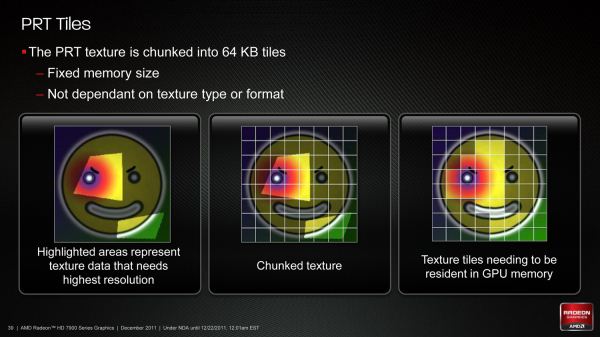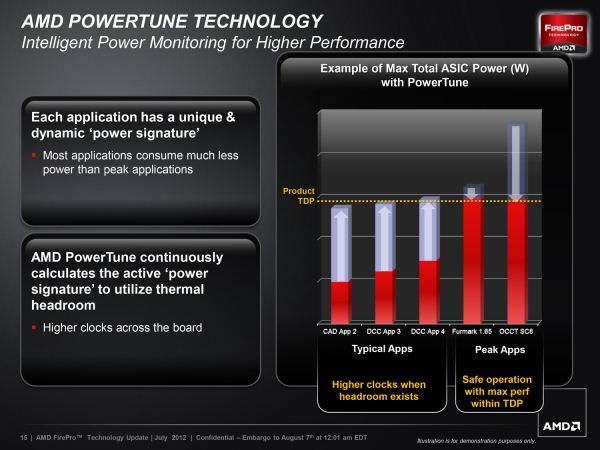The AMD FirePro W9000 & W8000 Review: Part 1
by Ryan Smith on August 14, 2012 4:00 AM ESTThe Rest of the FirePro W Series Feature Set
So far we’ve spent quite a bit of time talking about the FirePro W series in reference to AMD’s GCN architecture. Without question GCN is the single biggest change coming from AMD’s past products, but GCN is but one component of the Southern Islands family of GPUs that are the underpinning of this generation of AMD GPU products. Much like we’ve already seen on the desktop side of things there are a number of additional features Southern Islands brings with it that have some specific relevance in the professional graphics market.
Perhaps the single biggest improvement is that Southern Islands finally introduces full Error Correcting Code (ECC) memory support. In prior generations of GPUs AMD did not have any ECC support, with the closest thing being Error Detection & Correction (EDC), which could detect errors introduces across the memory bus (a very real concern with high-speed GDDR5) but no other type of errors. This admittedly isn’t a huge concern for the graphics workloads that past generations of FirePro specialized in, but moving forward for compute workloads it’s a critical feature due to the impact of errors.
So starting with the FirePro W series AMD will have full ECC support in selected models. This will include both ECC for internal SRAM caches (which is actually a free operation), and ECC for the external VRAM (accomplished through the use of a virtual ECC scheme). This functionality is going to be limited to products based on the Tahiti GPU, which means the W9000 and W8000. As Tahiti is AMD’s only GPU specifically configured for maximum compute performance, this comes as no great surprise. Consequently, the Pitcarin based W7000 and W5000 will have no such ECC support, mirroring their lower compute performance and emphasis on graphics.
Moving on, it came as a bit of a surprise to see AMD tout their Partially Resident Texture technology as a FirePro feature. We’re accustomed to thinking of PRT as a gaming technology – particularly due to the id Software Megatexture technology – but AMD tells us that it should be applicable to any kind of application using a large data set. More importantly however is the fact that since PRT can only be accessed under OpenGL right now, it’s far more accessible to professional graphics applications (which almost exclusively use OpenGL) as opposed to games and their heavy reliance on Direct3D. In any case we aren’t going to go into great detail about this technology since we’ve covered it before, but it should be interesting to see if AMD’s predictions are right.
Meanwhile, PowerTune marks its return on the FirePro W series. PowerTune, as you may recall, is AMD’s power throttling technology which is responsible for reining in on video card power consumption to keep it below a desired level. AMD has had PowerTune since the last-generation Cayman GPU, but it was only available on that GPU, meaning it wasn’t available on AMD’s top-tier FirePro cards such as the V9800. With The FirePro W series it’s finally available across AMD’s entire lineup, marking the first time it’s available to products like the W7000 and W5000. Given the latter’s sub-75W TDP, PowerTune is going to play an especially important role in making that possible.
Also seeing its introduction in Southern Islands and by extension the FirePro W series is PCI-Express 3.0 support. PCIe 3.0 doubles the effective transfer rate for a PCIe x16 slot to 16GB/sec in each direction, up from 8GB/sec in PCIe 2.0. This won’t make much of a difference for graphics workloads since they rarely consume 8GB/sec in the first place, but for compute workloads this is a critical feature. Any compute workloads that need to constantly send large amounts of data back and forth between the CPU and GPU should significantly benefit from this.
Finally, in another unexpected feature mention within AMD’s marketing materials, AMD is taking the time to mention their Video Codec Engine (VCE) hardware H.264 encoder, which was also introduced in Southern Islands. Both AMD and NVIDIA have been taking the time to mention their hardware video encoders in their respective professional graphics cards, which is unexpected given the fact that these hardware encoders are primarily intended for consumer uses such as quick video transcoding and video conferencing; neither encoder is up to the task of broadcast/archival quality video. Nevertheless, while neither company seems to have a solid idea of what to do with the hardware in the professional market, they’re throwing it out there in order to see what their customers can come up with.












35 Comments
View All Comments
cjb110 - Tuesday, August 14, 2012 - link
No interest in the product unfortunatly, but the article was a well written and interesting read.nathanddrews - Tuesday, August 14, 2012 - link
I certainly miss the days of softmodding consumer cards to pro cards. I think the last card I did it on was either the 8800GT or the 4850. Some of the improvements in rendering quality and drawing speed were astounding - but it certainly nerfed gaming capability. It's a shame (from a consumer perspective) to no longer be able to softmod.augiem - Thursday, August 16, 2012 - link
I miss those days too, but I have to say I never saw any improvement in Maya sadly over the course of 3 different generations of softmodded cards. And I spent so much time and effort researching the right card models, etc. I think the benefits for Autocad and such must have been more pronounced than Maya.mura - Tuesday, August 14, 2012 - link
I understand, how important it is to validate and bug-fix these cards, it is not the same, if a card malfunctions under Battlefield3 or some kind of an engineering software - but is such a premium price necessary?I know, this is the market - everybody tries to acheive maximum profit, but seeing these prices, and comparing the specs with consumer cards, which cost a fraction - I don't see the bleeding-edge, I don't see the added value.
bhima - Tuesday, August 14, 2012 - link
Who has chatted with some of the guys at Autodesk: They use high-end gaming cards. Not sure if they ALL do, but a good portion of them do simply because of the cost of these "professional" cards.wiyosaya - Thursday, August 16, 2012 - link
Exactly my point. If the developers at a high-end company like Autodesk use gaming cards, that speaks volumes.People expect that they will get better service, too, if a bug crops up. Well, even in the consumer market, I have an LG monitor that was seen by nVidia drivers as an HD TV, and kept me from using the 1980x1200 resolution of the monitor. I reported this to nVidia and within days, there was a beta version of the drivers that had fixed the problem.
As I see it, the reality is that if you have a problem, there is no guarantee that the vendor will fix it no matter how much you paid for the card. Just look at t heir license agreement. Somewhere in the agreement, it is likely that you will find some clause that says that they do not guarantee a fix to any of the problems that you may report.
bwoochowski - Tuesday, August 14, 2012 - link
No one seems to be asking the hard questions of AMD:1) What happened to the 1/2 rate double precision FP performance that we were supposed to see on professional GCN cards?
2) Now that we're barely starting to see some support for the cl_khr_fp4 header, when can we expect the compiler to support the full suite of options? When will OpenCL 1.2 be fully supported?
3) Why mention the FirePro S8000 in press reports and never release it? I have to wonder about how much time and effort was wasted on adding support for the S8000 to the HMPP and other compilers.
I suppose it's pointless to even ask about any kind of accelerated infiniband features at this point.
With the impending shift to hybrid clusters in the HPC segment, I find it baffling that AMD would choose to kill off their dedicated compute card now. Since the release of the 4870 they had been attracting developers that were eager to capitalize on the cheap double precision fp performance. Now that these applications are ready to make the jump from a single PC to large clusters, the upgrade path doesn't exist. By this time next year there won't be anyone left developing on AMD APP, they'll all have moved back to CUDA. Brilliant move, AMD.
N4g4rok - Tuesday, August 14, 2012 - link
Providing they don't develop new hardware to meet that need. Keeping older variations of dedicated compute cards wouldn't make any sense for moving into large cluster computing. They could keep that same line, but it would need an overall anyway. why not end it and start something new?boeush - Tuesday, August 14, 2012 - link
"I find it baffling that AMD would choose to kill off their dedicated compute card now."It's not that they won't have a compute card (their graphics card is simply pulling double duty under this new plan.) The real issue is, to quote from the article:
"they may be underpricing NVIDIA’s best Quadro, but right now they’re going to be charging well more than NVIDIA’s best Tesla card. So there’s a real risk right now that FirePro for compute may be a complete non-starter once Tesla K20 arrives at the end of the year."
I find this approach by AMD baffling indeed. It's as if they just decided to abdicate whatever share they had of the HPC market. A very odd stance to take, particularly if they are as invested in OpenCL as they would like everyone to believe. The more time passes, and the more established code is created around CUDA, the harder it will become for AMD to push OpenCL in the HPC space.
CeriseCogburn - Wednesday, August 29, 2012 - link
LOL - thank you, as the amd epic fail is written all over that.Mentally ill self sabotage, what else can it be when you're amd.
The have their little fanboys yapping opencl now for years on end, and they lack full support for ver 1.2 - LOL
It's sad - so sad, it's funny.
Actually that really is sad, I feel sorry for them they are such freaking failures.